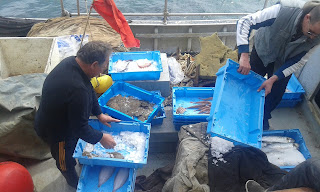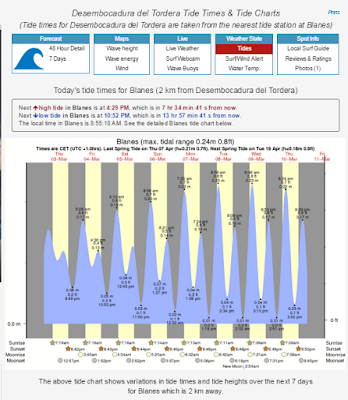The sand composition of Cala Sant Francesc (also named Cala Bona)
we have founded ...
|
|
Volume
|
General
shape of the clasts
|
|
|
gravel
|
sand
|
fine
soil
|
angular
|
subangular |
subrounded |
rounded |
Organic
structures remains
(shells,
sea urchin quills...);
they
react with H Cl |
bioclasts * |
x
|
x
|
x
|
|
x
|
x
|
|
Pink,
white, orange colors
bright,
round,
they
react with H Cl |
calcite |
|
|
|
|
|
|
|
Dark
and bright,
it
is easily broken with the needle
|
biotite |
|
|
|
|
|
|
|
Dark
,
it
does not break easily with the needle
|
rare
earth
minerals |
|
x
|
|
|
|
|
x
|
Colourless,
white or grey
often
it has flat surfaces,
it
seems glass |
quartz |
|
x
|
|
|
|
|
x
|
| Fragments
formed several minerals with different colours
|
rock
fragments |
x
|
x
|
|
|
|
x
|
|
Pink
colours amd matt
|
orthoclase |
|
x
|
|
|
|
x
|
|
note: there was some gravel size of rock fragments.
data table adapted from the book CTMA-I Castellnou Edicions, BCN 2003
The sand has other particles* such as...
we have founded ...
 |
| 3-remains of algae |
 |
| 1- corall remains 2-molluscs |
|
 |
| 4-smalls crabs and sea urchin |
 |
| 5- sea snails |
Height and diameter of a hep of sand
After making the funnel, we have poured the sand through it twice. We have put a piece of absorbent paper underneath, in order to prenent sand grains from spreading over the taeble, what had happened the first time we had tried it. Finally, we have measured it with a tape measure.
The longshore drift and the man-made structures
 |
| <http://vle.caldew.cumbria.sch.uk/pluginfile.php/7497/mod_resource/content/0/Untitled.jpg> |
 |
| adapted from the anterior |
It alter the shape of beaches because the sand can not do (
//) the lateral displacement and piles up on one side of the man-made structure.
Nanou, Guillem, Pau and their teacher have decided to try to improve performance ... and we believe they have got it.
Height and diameter of a heap of sand
1· We measured 1L. of sand with a calibrated container.
2· We made a funnel with a corner of a Tetra Pak making a hole of 2.5 cm. in the longest side.
3· We fixed the funned to the support and the funell at 40 cm. high.
4· We put a metallic tray under the brick and the support , and two kitchen papers on top to collect better the sand and prevent the grains from bouncing. We put the tray onto a cardboard box.
5· We throw the sand slowly to obtain a mountain.
6· We get a mountain of 5 cm. height with a base of 15 cm.
1·Vam mesurar amb una gerra mesurada una quantitat de 1 L. de sorra
2·Vam fer un embut amb l'angle d'un "tetrabrick" que tenia una obertura de 2.5 cm. al cantò més llarg.
3·Vam fer un muntatge amb el suport i el "brick" fent d'embut a 40 cm. d'altura
4·A sota vam posar una safata metàl·lica amb les vores una mica aixecades i dos papers de cuina al damunt per així recollir millor la sorra i evitar que reboti, vam obrir una capsa i ho vam posar també al voltant per tal de que no s'escampes la sorra.
5·Vam tirar la sorra a poc a poc per tal de que es crees una muntanya.
6·Vam obtenir una muntanya de 5 cm. d'alçada amb una base d'uns 15 cm.
Granulometria
To know what is the structure of the sand, we used calibrated sieves we had in the lab and then we obtained the following results:
Per tal de conéixer quina es l'estructura dels grans de sorra, vam aprofitar els tamisos calibrats que teniem al laboratori i vam obtenir els següents resultats:
1· We sized 1 liter of sand.
2· We measured it in the balance with the metalic tray included; remaining the weight of the tray we get the net weight.
3· Net weight = Gross weight - Tare = 1930,4 g. - 306,2 g. = 1624,1 g.
4· We obtained the density of the sand :D=M/V = 1624,1 g./1000 cm3 = 1,624 g/cm3
5· We ordered the sieves by sizes, the sieve which had the mesh opening more biggest (2mm), then the 1mm and then the 0.8mm.
1·Vam mesurar un litre de sorra
2·Vam pesar-lo a la balança amb la safata inclosa; restant el pes de la safata vam obtenir el pes net.
3·Pes net = Pes brut - Tara = 1930,4 g. - 306,2 g. = 1624,1 g.
4·Vam poder trobar la densitat de la sorra : D=M/V = 1624,1 g./1000 cm3 = 1,624 g/cm3
5·Vam ordenar els tamisos per mides; el que tenia la obertura malla més gran era de 2 mm. , desprès el d'1mm. , el de 0.8mm.
|
Net weight of the fraction
|
Percentage
|
Sand > 2mm.
|
1492,8 g.
|
91,47 %
|
Sand < 2mm. > 1mm
|
125,6 g.
|
7,73 %
|
Sand < 1mm. > 0,8mm
|
5,2 g.
|
0,47%
|
Sand < 0,8 mm
|
0,5 g.
|
0,32 %
|
Total
|
1624,1 g.
|
100%
|
























































